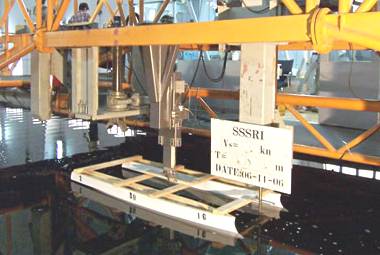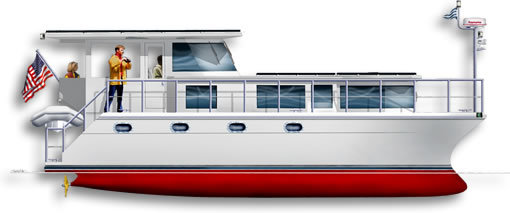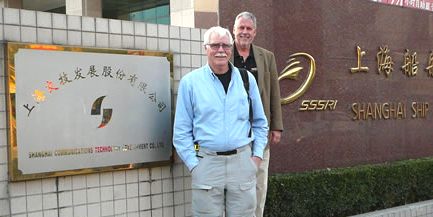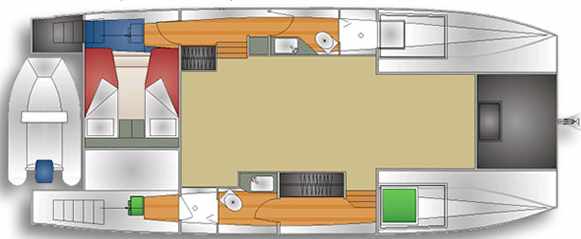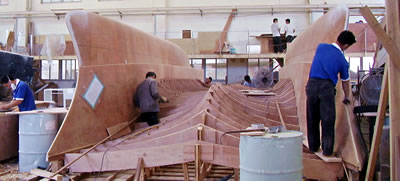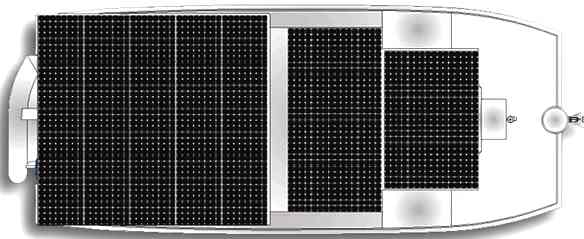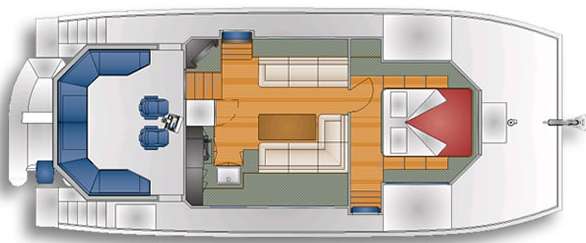|
DSE ISLAND PILOT HYBRID
|
|
|
HOME | BIOLOGY | FILMS | GEOGRAPHY | HISTORY | INDEX | INVESTORS | MUSIC | SOLAR BOATS | SPORT |
|
|
DSE ISLAND PILOT HYBRID
The DSe Hybrid - the first truly “Green” motoryacht in the U.S. - took shape as all the parameters were developed. The goals are:
1. 6 Knots under solar power only. 2. Two good staterooms with ensuite heads for two couples or a family cruising together. 3. Economy both underway at any speed plus efficient living on the hook. 4. Spacious and comfortable “Great Room.” 5. Roomy and congenial Pilot House. 6. All the “optional” equipment included as standard to which all current Island Pilot owners have become accustomed.
The DSe catamaran hull undergoing tank testing First came a pair of sleek hulls, their underwater shapes resembling a torpedo. The DSe requires a total 0f 6,000 watts to cruise at 7 knots (see tank test results). The superstructure is designed to maximize the horizontal surface for the 6.6 kW photovoltaic solar array.
In the bow of each hull is an (25kW, variable-speed, high voltage DC in sound shied) powered by a Mercedes-engineered 1-litre diesel developed for the Smart Car in Europe. Below the cabin soles are AGM-style deep cycle batteries - a total of 24kW/Hours. Underneath the settee in the guest stateroom in the port hull and in the machinery room in the starboard hull are the Ossa Powerlite hi-voltage 35 HP motors. Operation is seamless — the DSe cruises silently at slow speeds with the variable-speed generator(s) starting automatically as power needs increase.
None of this cutting-edge technology takes away from her comforts — One “Island Queen” on-deck master & one “Island Queen” guest (converts to twin berths), each with ensuite heads and stall showers. The “Great-room” deckhouse has a roomy & efficient galley (complete with the Island Pilot signature refrigerator/freezer). The two settees, high-low table and 26” HDTV and Bose home theater have all been proven in the Island Pilots and actually are enlarged for use here in the DSe Hybrid.
The express-style bridge has wrap-around seating for 8, twin helm chairs (the same sports car seats found in the Island Pilots) and pull-out, rotatable console housing the Raymarine E120 multiscreen, the Ossa Powerlite LCD touchscreen control panel, Raymarine autopilot (now under development) and the Joystick. You can rotate the console to face either helm position or push it forward giving you space to stand while helming and maneuvering the DSe.
The DSe Hybrid measures 39’ 6” x 17’ 0” x 26”
Now,
Island Pilot LLC creates an entirely new set of standards with the
revolutionary
• America’s first Diesel—Solar—Electric Drive Train • Up to 7 knots using only her 6.6 kW Solar Array • Up to 2 hours running using her battery bank • Up to 3 NM/Gallon at 13 knot cruise • Seamless operation between solar, battery and Ossa Powerlite diesel generator power • On-deck master stateroom (just forward of the deckhouse) with island queen berth facing forward so you can enjoy the 270 degree panorama provided by her 30” high windows on three sides — Steps lead down to the extensive dressing room and head in the starboard hull • Expansive guest suite to port with ensuite head, dressing room and island queen berth that converts to a pair of single berths • Large deckhouse and pilothouse with U-shaped galley, L-shaped settee with additional settee to port •
Fully equipped — as would be expected
Operation of the DSe Hybrid:
1. At the dock.
While at the dock, the DSe will be plugged into shore power with a pair of 120 VAC/30 Amp shore power cables (same as we use on the Island Pilot 395/435s). One 30 Amp lead will go to the dedicated hi-voltage battery charger - the other for domestic systems.
We are using hi-voltage DC for the cooktop, hot water and air conditioning. These items will be powered via the charger and battery bank.
There is a DC/DC converter providing charging power to a minimum 12 VDC system. This system will be used for electronics and domestic systems (heads, pumps, lighting, etc.).
120 Volt domestic systems will be powered directly by the 2nd shore power - this would include TVs, Bose home theater, satellite system, refrigerator (our signature hi-tech Japanese with one door and four drawers), GE Profile Avantium microwave/convection oven, outlets, etc.
Reuben Trane and George Petrie at the Shanghai Ship Research Institute
2. At anchor.
While at anchor during the day, primary power source is the high voltage 6kW solar array. This will be wired, via a voltage regulator, to the the main high-voltage DC buss. Also wired to this DC buss are the generators and the 24kW, high voltage battery array. The generator control panel (touch screen LCD) will have an “At Anchor - Minimum Generator” setting. This will prevent the generator(s) from starting needlessly. This setting is to be used when there are minimum electrical demands and/or you are planning on staying at anchor for several days or more, allowing the battery bank to be recharged from the solar array. The battery bank and, as necessary, the generator(s) provide power at night.
If you are not planning on staying at anchor long enough to recharge your batteries from the solar array, then you would choose the “At Anchor - Generator” setting. With this setting, the generator(s) would start as soon as power demands exceed the solar array, thus avoiding depleting the battery bank. If you’re spending the night without high electrical demands (i.e. no air condtioning) you would choose the “Minimum Generator” setting to avoid the generator(s) from starting in the middle of the night. The minimal electric use during the night will not deplete the battery bank significantly.
The hi-voltage DC items will use energy from the solar and battery array (the cooktop, hot water and air conditioning). Should the power demands exceed the available energy, then the generator(s) will start automatically.
The DC/DC converter will provide 12 VDC using the high voltage from the solar and/or battery bank for electronics and domestic systems.
120 Volt domestic systems will be powered by a high voltage DC/120 VAC inverter.
DSe Island Pilot catamaran - Guest bunks, heads and machinery
3. Underway.
When you’re ready to leave the dock or pick up anchor, you first choose your operating mode depending on your day’s proposed cruising. If you plan a slow cruise on a sunny day where the solar array will meet power demands or an evening cocktail cruise where you plan on returning to your slip (letting you replenish the batteries on shore power), then you would choose “Underway - Minimum Generator.” (This is similar to the at anchor - minimum generator setting.) This is your “Silent Running” setting.
If you have plans to drive a bit faster and/or the day is overcast and you do not plan on returning to your slip or sitting at anchor long enough to recharge the batteries from solar, you would choose “Underway - Solar/Generator” setting. As your power needs exceed that available from the solar array, the generator(s) will start up supplying the additional power. (NOTE: you can see by the graphs on the Tank Test Results page that fuel requirements at speed are reduced depending on the amount of energy boost coming from the solar array - there are graphs for 6kW boost, 3kW boost and Zero boost.) This would be your “Fast Cruising” setting, allowing you to put miles under your keel in an efficient manner and ending the day with a fully-charged battery bank.
One thing to remember: You do not, as a rule, want to charge a depleted battery bank from the generator(s). It is more efficient to use the generator(s) in the first place to supply the needed power, whether to run the air conditioning or to drive fast. In other words, using the generator(s) to charge batteries uses more fuel than if you’d used the generator(s) to provide the needed power in the first place. Of course, a quiet night on the hook trumps saving that last ounce of fuel.
The DSe catamaran hull under construction
4. Driving
There is no ignition switch on the DSe Hybrid.
Once you’re ready to leave the dock or pick up the anchor, you first choose your mode of operation (see #3 above).
Then you slide the joystick back. The electric motors slowly slide the DSe out of your boat slip. You rotate the joystick and the DSe rotates in place - one motor in reverse, the other in forward. Then slide the joystick forward and motor out of your marina.
As you accelerate beyond the capabilities of the solar array (assuming you’ve chosen the “Solar/Generator” mode), the generator(s) start automatically providing additional power as needed.
Steering is done by angling the joystick left or right - this speeds up one motor while slowing the other providing differential steering.
Reach your destination and slow down, the generator(s) stop automatically and you enter the marina or anchorage silently.
The joystick will have friction and remain where set.
Raymarine is working with Island Pilot and Ossa Powerlite to develop the hardware/software interface for their autopilot to work with the DSe’s rudder-less steering.
DSe Island Pilot catamaran solar panels layout
5. A word about batteries
The DSe’s primary source of power is the Sun. The secondary source are the variable-speed, high voltage DC generators. Both these sources meet the battery array at the main high-voltage DC buss. The DSe is NOT a battery operated boat. The batteries are there for overnight domestic use, short “sunset cocktail cruises” and to act as a buffer.
That being said, we have decided on the most robust batteries we can find - AGM-style “True Lead” from Enersys here in the U.S. In discussions with their engineers, we learned as much as we could about the “life” of a battery, especially based on the DSe’s application.
The “life” of a battery can best be compared to a large tank of fuel - once it’s gone, it’s gone. You can use that “fuel” quickly or at a slower pace, but you end up using a finate amount of energy. If you you think of the total Watt/Hours of use, AGM-style batteries are similar. If you discharge them 25% at each use, you’ll get twice the number of uses than if you’d discharged them 50% each time. Total energy use is about the same. The engineers at Enersys tells us that the “life” of their “True Lead” batteries is 400 FULL DISCHARGES. So, whether you use them up in a year or 5 years, is up to how you use your DSe. Our feeling is that the batteries are there to be used and enjoyed.
DSe Island Pilot catamaran - Galley, Salon and Master cabin
LINKS and CONTACTS
DSe Home | Introduction | Features | Plans | Operation | Flow Chart | Boat Shows Development |DSe Hybrid Press
Island Pilot Details | Island Pilot Plans | Island Pilot Photos | Island Pilot NEWS Bits & Pieces | Press Room
Island Pilot LLC 8260 SW 159 St. Palmetto Bay Florida 33157 888.443.2965
EDUCATIONAL LINKS
http://www.testking.com/000-176.htm http://www.testking.com/techking/ http://www.certkiller.com/RHCE-certification-training.htm examsheets 640-822 648-375 648-244 braindumps E20-390 VCPC510 A00-212 200-001 ccnp 352-001 http://www.testkingsite.com/microsoft/70-686.html
|
|
|
This website is Copyright © 1999 & 2013. The bird logos and name Solar Navigator are trademarks. All rights reserved. All other trademarks are hereby acknowledged. Max Energy Limited is an educational charity. |
|

